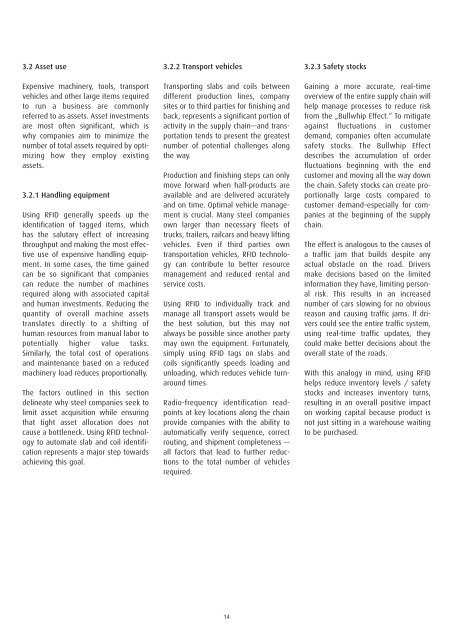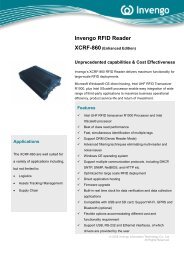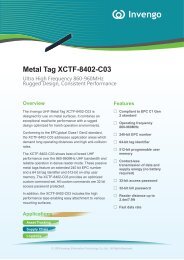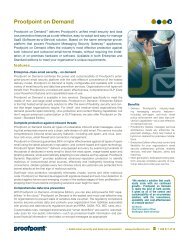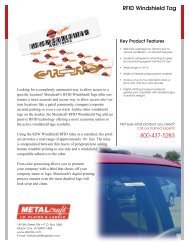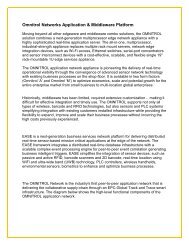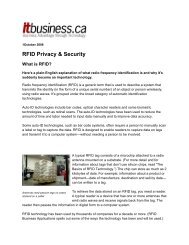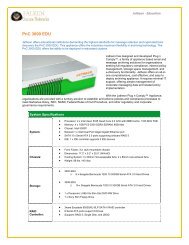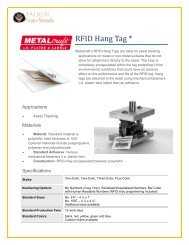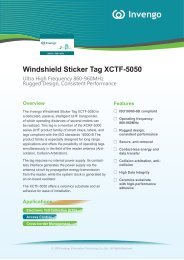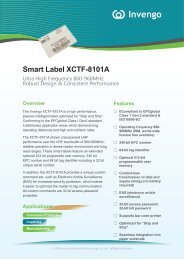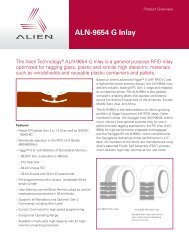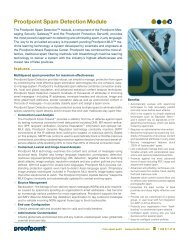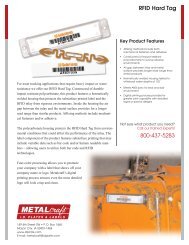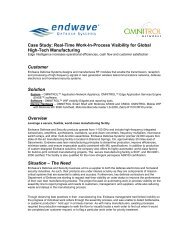The Benefits of RFID for Slab- and Coil-Logistics - Falken Secure ...
The Benefits of RFID for Slab- and Coil-Logistics - Falken Secure ...
The Benefits of RFID for Slab- and Coil-Logistics - Falken Secure ...
Create successful ePaper yourself
Turn your PDF publications into a flip-book with our unique Google optimized e-Paper software.
3.2 Asset use<br />
Expensive machinery, tools, transport<br />
vehicles <strong>and</strong> other large items required<br />
to run a business are commonly<br />
referred to as assets. Asset investments<br />
are most <strong>of</strong>ten significant, which is<br />
why companies aim to minimize the<br />
number <strong>of</strong> total assets required by optimizing<br />
how they employ existing<br />
assets.<br />
3.2.1 H<strong>and</strong>ling equipment<br />
Using <strong>RFID</strong> generally speeds up the<br />
identification <strong>of</strong> tagged items, which<br />
has the salutary effect <strong>of</strong> increasing<br />
throughput <strong>and</strong> making the most effective<br />
use <strong>of</strong> expensive h<strong>and</strong>ling equipment.<br />
In some cases, the time gained<br />
can be so significant that companies<br />
can reduce the number <strong>of</strong> machines<br />
required along with associated capital<br />
<strong>and</strong> human investments. Reducing the<br />
quantity <strong>of</strong> overall machine assets<br />
translates directly to a shifting <strong>of</strong><br />
human resources from manual labor to<br />
potentially higher value tasks.<br />
Similarly, the total cost <strong>of</strong> operations<br />
<strong>and</strong> maintenance based on a reduced<br />
machinery load reduces proportionally.<br />
<strong>The</strong> factors outlined in this section<br />
delineate why steel companies seek to<br />
limit asset acquisition while ensuring<br />
that tight asset allocation does not<br />
cause a bottleneck. Using <strong>RFID</strong> technology<br />
to automate slab <strong>and</strong> coil identification<br />
represents a major step towards<br />
achieving this goal.<br />
3.2.2 Transport vehicles<br />
Transporting slabs <strong>and</strong> coils between<br />
different production lines, company<br />
sites or to third parties <strong>for</strong> finishing <strong>and</strong><br />
back, represents a significant portion <strong>of</strong><br />
activity in the supply chain—<strong>and</strong> transportation<br />
tends to present the greatest<br />
number <strong>of</strong> potential challenges along<br />
the way.<br />
Production <strong>and</strong> finishing steps can only<br />
move <strong>for</strong>ward when half-products are<br />
available <strong>and</strong> are delivered accurately<br />
<strong>and</strong> on time. Optimal vehicle management<br />
is crucial. Many steel companies<br />
own larger than necessary fleets <strong>of</strong><br />
trucks, trailers, railcars <strong>and</strong> heavy lifting<br />
vehicles. Even if third parties own<br />
transportation vehicles, <strong>RFID</strong> technology<br />
can contribute to better resource<br />
management <strong>and</strong> reduced rental <strong>and</strong><br />
service costs.<br />
Using <strong>RFID</strong> to individually track <strong>and</strong><br />
manage all transport assets would be<br />
the best solution, but this may not<br />
always be possible since another party<br />
may own the equipment. Fortunately,<br />
simply using <strong>RFID</strong> tags on slabs <strong>and</strong><br />
coils significantly speeds loading <strong>and</strong><br />
unloading, which reduces vehicle turnaround<br />
times.<br />
Radio-frequency identification readpoints<br />
at key locations along the chain<br />
provide companies with the ability to<br />
automatically verify sequence, correct<br />
routing, <strong>and</strong> shipment completeness —<br />
all factors that lead to further reductions<br />
to the total number <strong>of</strong> vehicles<br />
required.<br />
14<br />
3.2.3 Safety stocks<br />
Gaining a more accurate, real-time<br />
overview <strong>of</strong> the entire supply chain will<br />
help manage processes to reduce risk<br />
from the „Bullwhip Effect.“ To mitigate<br />
against fluctuations in customer<br />
dem<strong>and</strong>, companies <strong>of</strong>ten accumulate<br />
safety stocks. <strong>The</strong> Bullwhip Effect<br />
describes the accumulation <strong>of</strong> order<br />
fluctuations beginning with the end<br />
customer <strong>and</strong> moving all the way down<br />
the chain. Safety stocks can create proportionally<br />
large costs compared to<br />
customer dem<strong>and</strong>–especially <strong>for</strong> companies<br />
at the beginning <strong>of</strong> the supply<br />
chain.<br />
<strong>The</strong> effect is analogous to the causes <strong>of</strong><br />
a traffic jam that builds despite any<br />
actual obstacle on the road. Drivers<br />
make decisions based on the limited<br />
in<strong>for</strong>mation they have, limiting personal<br />
risk. This results in an increased<br />
number <strong>of</strong> cars slowing <strong>for</strong> no obvious<br />
reason <strong>and</strong> causing traffic jams. If drivers<br />
could see the entire traffic system,<br />
using real-time traffic updates, they<br />
could make better decisions about the<br />
overall state <strong>of</strong> the roads.<br />
With this analogy in mind, using <strong>RFID</strong><br />
helps reduce inventory levels / safety<br />
stocks <strong>and</strong> increases inventory turns,<br />
resulting in an overall positive impact<br />
on working capital because product is<br />
not just sitting in a warehouse waiting<br />
to be purchased.


